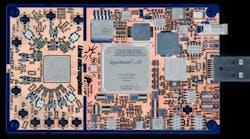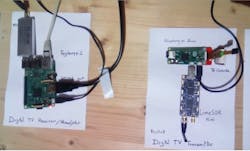MWRF: Can you tell us about this digital TV transmitter?
EB: This is a prototype based on the Raspberry Pi Zero and LimeSDR Mini. The Raspberry Pi’s capabilities are well known; the LimeSDR Mini is a very low-cost ($139) SDR board with a range between 100 MHz and 3.5 GHz (extendable to 10 GHz with a companion board). It uses software to define the radio function. Applications include the Internet of Things (IoT), LTE, 3G, ham radio, etc. Designers can both create their own apps in a range of languages or download them via the Ubuntu store.
MWRF: How do you plan to attract future engineers with this product?
EB: We want as many people designing as many different applications as possible, and this perfectly shows off the capabilities of the LimeSDR. If the developer will take it to market, that’s fantastic. If not, we’re delighted that he has shown his workings so others can do the same.
MWRF: For what applications do you think it will be most popular?
EB: IoT and telecom will be significant applications for the LimeSDR boards (EE and Vodafone have already backed the Lime SDR projects). Other applications include test and measurement, DVB, GNSS, and even 5G (ABI predicts the 3.5 GHz band will be the key one in deploying mass market 5G).
MWRF: What are the most common challenges that newbies have when they start with Pi?
EB: The Pi and the LimeSDR have a lot of commonalities. Both were made to bring [the greatest number of] people into computing and radio, respectively, by making it as easy to program as possible and as affordable as possible. One of the elements we’re working with Seeed Studio on is to give people an easy way in and on the LimeSDR Mini Crowd Supply page (our sales channel) you can now also get a Grove Start Kit for the Raspberry Pi that comes with a LimeSDR Mini included ($249).


